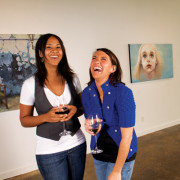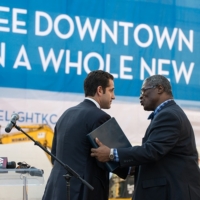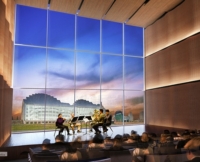Millennials discover Downtown KC a friendly place to be
You can find them where there’s live music, trendy food, an affordable home and a friendly environment where they feel they can make a difference.
And in some very encouraging ways, both statistically and in the mysterious world of “buzz,” the Kansas City area is holding its own when it comes to appealing to the hot demographic called millennials. A study recently ranked us among the top 20 big U.S. metros when it came to adding young adults, according to a recent story in The Kansas City Star.
It’s not just about being hip. Attracting those people born roughly between 1982 and 2004 is considered vital to the metro’s economic future.
Reporter Kevin Collison’s story went on to say:
Just recently, MindMixer, an Omaha Web-hosting firm, announced it was moving to the Crossroads Arts District and creating 85 jobs, citing the area’s urban vibe and pool of tech-savvy people.
To help further that favorable impression, the Kansas City Area Development Council launched a talent recruitment initiative to help local companies sell the area to young potential employees.
Among its tactics is a scavenger hunt aimed at getting summer interns — brought to the area by big local corporations such as Hallmark, Cerner and Garmin — off the couch and discovering the charms of places including Brookside, Westport and the River Market.
Having more young people around also makes this a better place to live for all generations.
Mayor Sly James, whose streetcar push is particularly appealing to the millennials’ affinity for urban living, said keeping and adding that age group to the local mix was a formula for a better future.
“The value and importance is that these are the people who’ll be energizing us,” he said. “We need that creative, young class to keep us sharp and keep us on the edge as we rapidly change.”
When it comes to hard numbers, the area ranked 14th among the nation’s 51 metros with populations over a million when it came to adding young adults, according to a recent report from the Brookings Institution.
The Kansas City metro had an annual net gain of about 2,200 people in the 25 to 34 age group during the three-year period from 2009 to 2012. Though far below red-hot places such as Denver, which added almost 12,000 young adults each year, it ranked ahead of Atlanta, New York, Boston and Los Angeles.
The area also is doing well in the online universe of social media, that place where buzz is generated and many younger adults pick up their impression of places.
Travel + Leisure named Kansas City the 10th best city for hipsters in the nation — ahead of Seattle, Boston and Minneapolis — while the Huffington Post included the area among “20 Awesome U.S. Cities You Need to Visit in Your 20s” and Vocativ ranked us 21st among the “35 Best U.S. Cities for People Under 35.”
That’s not surprising to Chel O’Reilly, who grew up in New England and lived in Brooklyn — considered hipster-central by many of her generation — for a year before coming here.
“I came to Kansas City three years ago to visit two friends for four days and when I left, I had a job offer,” O’Reilly said. “The music is great, and the camaraderie and friendly people here are great.… I find it to be very welcoming.”
At age 35, O’Reilly considers herself on the cusp of the millennial generation, but she shares the interests often cited by young adults when it comes to where she wants to live.
“I love it that there’s a great art scene in Kansas City, the Charlotte Street Foundation and First Friday is amazing,” she said. “These are things I like to show off to people.”
One of the bigger draws listed by Vocativ, which bills itself as a “take-no-prisoners” online news source, was Kansas City’s affordability. The average monthly rent for a two-bedroom apartment here was $710, making the city the eighth cheapest place to live among the 35 cities that made the hipster list.
Adding to the inexpensive allure, Vocativ also found the seventh largest number of vintage clothing stores per capita here.
Living somewhere you can devote more time to your passions and less to paying rent is what appealed to Francisco Alarcon, a 31-year-old native of Spain.
He moved here last fall from Los Angeles after graduating from architecture school to work as a sports architect at Populous, but is an artist in his spare time.
“I was hesitant about the art scene here and I asked my friends in LA who told me Kansas City has one of the best art scenes in the U.S.,” he said. “It’s also cheap to live here.
“Making money in the creative world is a struggle. If you live in a city like New York, your rent is super-high. You don’t have the time to write or paint because you have to worry about paying the rent.”
Another architect colleague at Populous, Geoff Cheong, hails from Vancouver. After graduating from architecture school in British Columbia in 2007, he was invited by Populous to come to Kansas City for an interview.
“I didn’t know where Kansas City was,” the 30-year-old said. “On my first plane into town I was expecting the Wizard of Oz, wheat fields and tornadoes. I was pleasantly surprised to see it was lush and green and there was water.”
Cheong’s first home was a downtown loft, and he quickly discovered Kansas City was no Vancouver when it came to urban living. One of the missing ingredients was mass transit.
But with a car, Cheong enjoyed the ease of getting around the area. He now lives in a suburban apartment complex at Interstate 435 and Roe Avenue.
“I enjoyed slowing things down a little,” he said. “The (low) cost of living also was huge. Kansas City blows other cities out of the water.”
And in a surprising twist for a Canadian, he actually has more opportunities to play hockey here than he did in his hometown.
“It’s more affordable and there’s more rink time available,” he said. “I meet other Canadian transplants at hockey rinks.… I’ve lived here 6½ years now and I think that’s a credit to Kansas City.
“My friends in Vancouver ask when I’m moving back and I say I’m not.”
Alarcon also has found a welcoming place.
“I have a group of international expats and also artists,” he said. “It’s very diverse culturally and for me, it’s been very good.”
O’Reilly, the New England transplant, says its easy for millennials to find an “instant community” in Kansas City.
“Kansas City is rich with a lot of good people who open their arms to let more people in,” she said. “I don’t feel it’s a closed city.
“The tech and start-up community is fantastic, Google Fiber did a good job kick-starting that, and the Kauffman Center’s 1 Million Cups program is now in 32 cities.”
O’Reilly also belongs to a group of about two dozen younger adults who call themselves “Possum Trot,” an early historic name for the area. They include newcomers to the city as well as natives who gather regularly to socialize, discuss the city and invite speakers.
“It’s not an agenda-driven organization; it’s really about what’s happening in the city,” said Havis Wright, coordinator for the group. “It’s about familiarizing people who are new to the city and reacquainting people who’ve left and come back.”
Among those returnees involved in Possum Trot is Kathleen Bole.
The 25-year-old grew up in Prairie Village but left for graduate school at the University of Pennsylvania in Philadelphia in 2011. Bole also did internships in Washington and Chicago, so she knows a bit about what’s going on elsewhere in the nation.
“I packed my bags and moved East and didn’t think I’d come back,” she said.
But after graduating with a master’s degree in city planning in 2013, she began to think more fondly of her hometown.
“Kansas City doesn’t have a lot of things other cities have in the way of walkability and transit, but I like the work-life balance you can have here, which you don’t have as much on the coasts,” Bole said.
“Living in Philadelphia, I realized a young professional just coming out of school was not the easiest way of life, and you have a better quality of life here.
“A friend from D.C. visited me last night and she was astonished at how pretty it was, how nice it was and how cheap everything is.”
One of the biggest challenges facing Kansas City when it comes to attracting millennials is its an unknown quantity to most people around the country, Marcusse said.
“They think it’s a cow town or flyover place,” he said.
“A lot just don’t have a perception of Kansas City, and you’re starting from ground zero. Once they’ve been here, they fall in love. It’s just getting them here.”
Using the theme of “America’s Creative Crossroads” (KCCreativeCrossroads.com), the organization has developed marketing materials, both online videos and printed, aimed at appealing to millennials.
Attributes included the city’s music scene, restaurants and food trucks, the appeal of professoinal soccer with Sporting Kansas City, the tech scene and Google Fiber and, of course, the relatively low cost of living here.
One of the more fun initiatives is the scavenger hunt launched last year.
About 1,000 summer interns participated. Each received a booklet listing 11 areas of the metro from greater downtown and midtown, to southern Johnson County and the Village West area of western Wyandotte County.
Five different attractions were listed for each area, and participants were invited to find them, take photos and post them on Facebook to score points. Prizes were awarded based on the places explored.
“The idea was to give them an opportunity to see the city,” Marcusse said. “If they just stayed in their apartment, they may not know the city when it was time to think about a job.”
Looking forward, while Kansas City has done reasonably well attracting millennials, those interviewed agreed the community could do a much better job if it had more walkable neighborhoods and mass transit.
“I think the streetcar is a huge thing,” Bole said. “Knowing it was on the horizon meant a lot to me.
“I’m also someone who loves to walk and I’m used to walking a mile or more. Here, there’s so many dead zones which makes it feel less appealing.”
To liven things up at the street level, the Downtown Council has embraced what’s called “tactical urbanism.” It’s intended to be a low-cost way to show the possibilities of making the city a more enjoyable and engaging place.
For example, in 2012 design students from Kansas State University used inexpensive materials to temporarily transformed two blocks of Grand Boulevard into a narrower, more attractive street with wide sidewalks, landscaping and sidewalk cafes. The idea was to offer a glimpse at how a more liveable street could be created.
Mike Hurd, marketing director for the Downtown Council, said the new tactical urbanism being pursued by his organization is designed to create a downtown “eco-system” for millennials.
“What we find with millennials is a desire to see more activity on the streets and public spaces on an ongoing basis, not just big event nights,” he said.
This summer, the Downtown Council is planning on holding noontime events twice a month at Oppenstein Park at 12th and Walnut streets with food trucks and entertainment.
A plan also is evolving to hold monthly free concerts in the Crossroads Arts District on a Friday evening other than First Friday, the popular art gallery event.
Dave Scott, chairman of the tactical urbanism program, said the emphasis is on inexpensive ideas to improve the urban environment.
“We’ll win the battle if it’s a good place to live and work, and it’s fun and unpredictable,” he said.
The major reinvestments in making downtown more appealable plus the positive social media buzz has helped companies recruit new talent.
Bob White, director of international marketing at Populous, said his firm is finding it much easier these days thanks to the improvements that have occurred in the city.
“Ten or 15 years ago, it was extremely difficult for us to recruit young people,” he said. “It was frustrating for us and it was based on ignorance and things they had heard about Kansas City and the Midwest from other people.
“That’s flipped the last six or seven years. There is a groundswell, an undercurrent of young people, making this happen. People are less resistant and more open-minded.
“They’re saying ‘yes, I’ve heard there’s good things happening in Kansas City,’ hearing it from their peers that’s it’s worth a second look.
“We’re delighted by it.”



